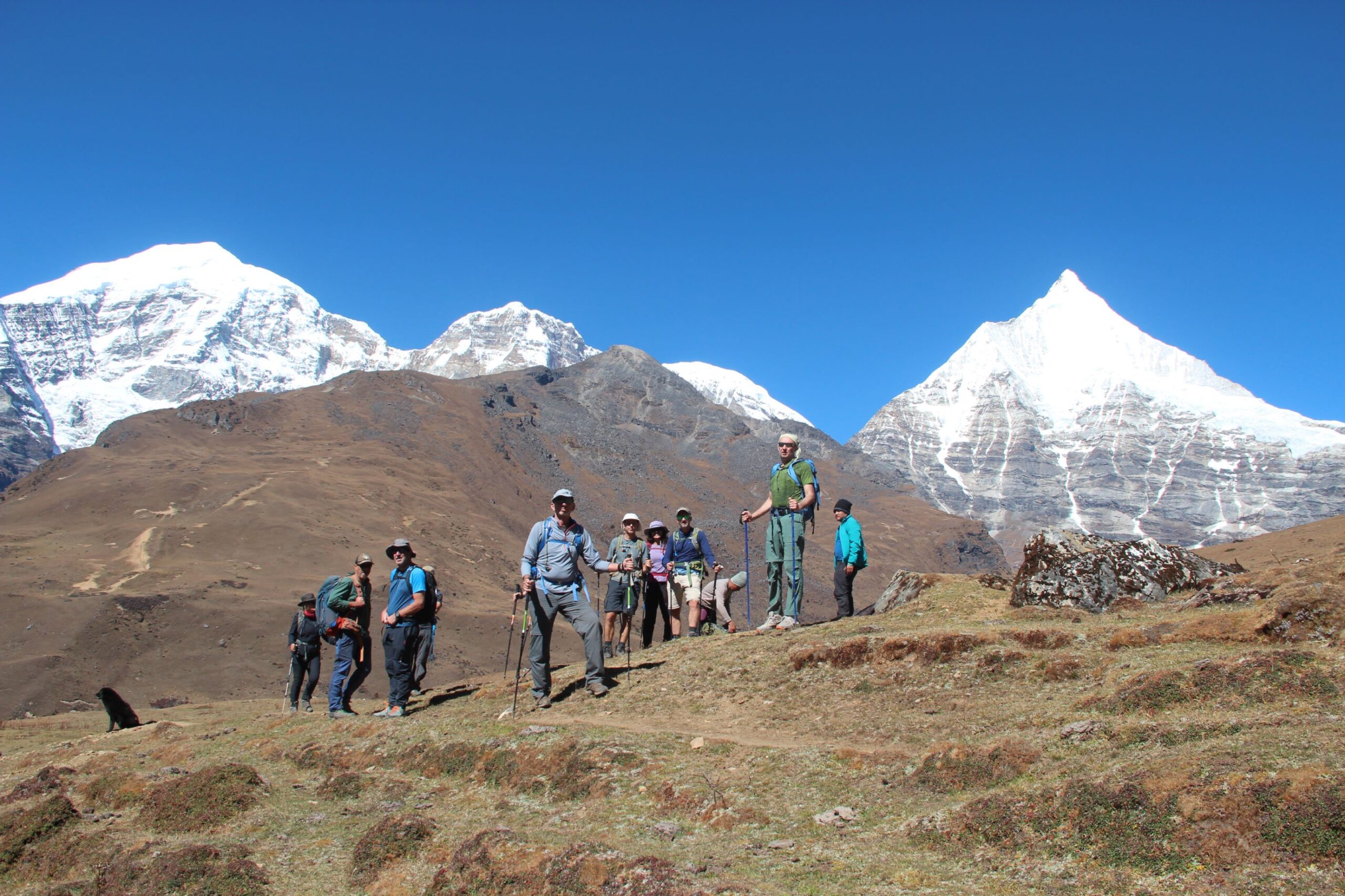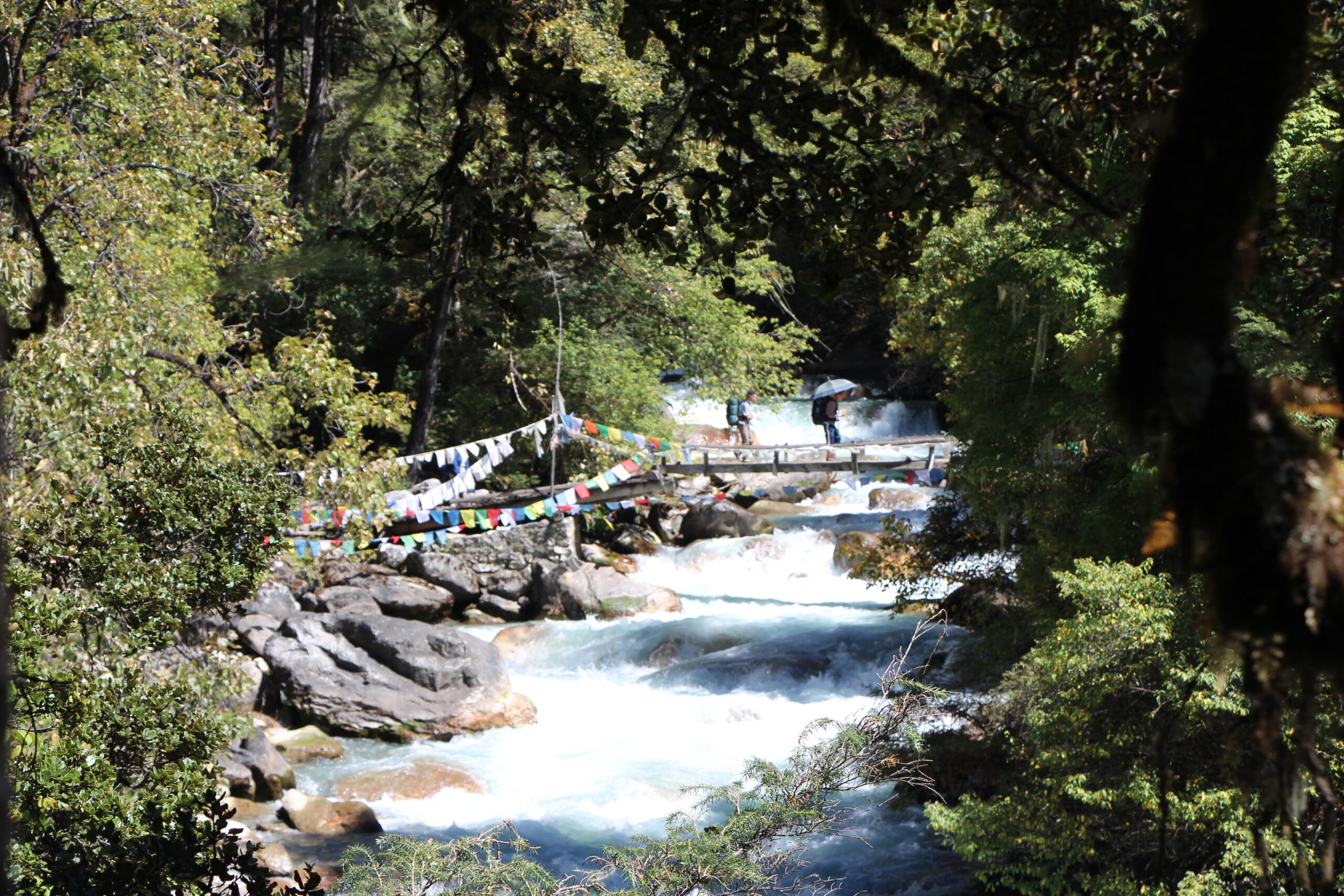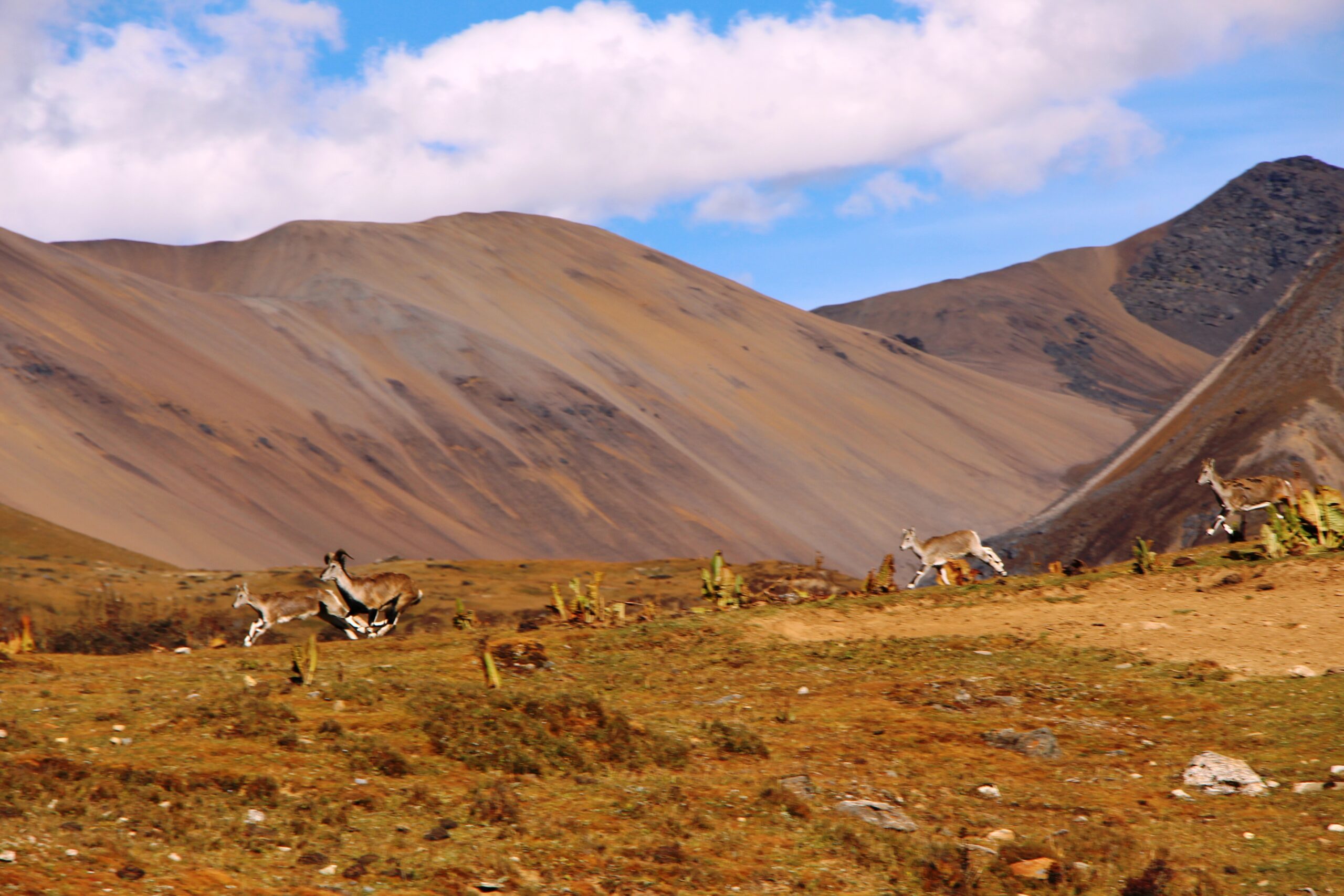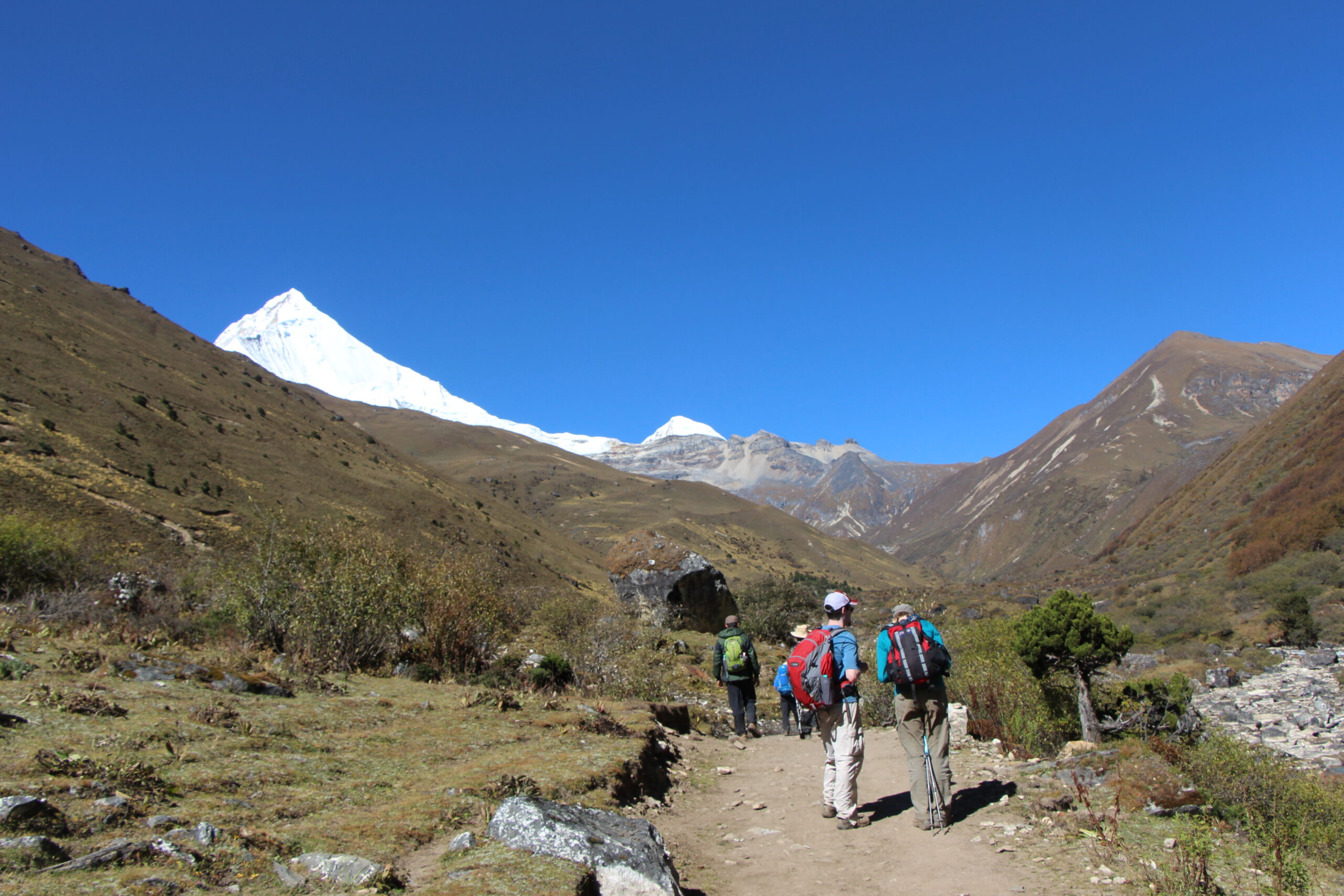The Jomolhari Trek in Bhutan is one of the most beautiful and popular high altitude treks in Bhutan. It has very good views of the mountains, and it proceeds through lovely alpine scenery on the way to good campsites. This trek also passes through several semi-nomadic villages.
This trek is also known as Snow Leopard or Soi Yaksa trek, and it lasts one week. If you are lucky, you may spot Himalayan Snow Leopard, and other Himalayan animals like Blue Sheep and Marmots will be seen quite often. The best time for this trek is in the spring and autumn months.
Trip Map
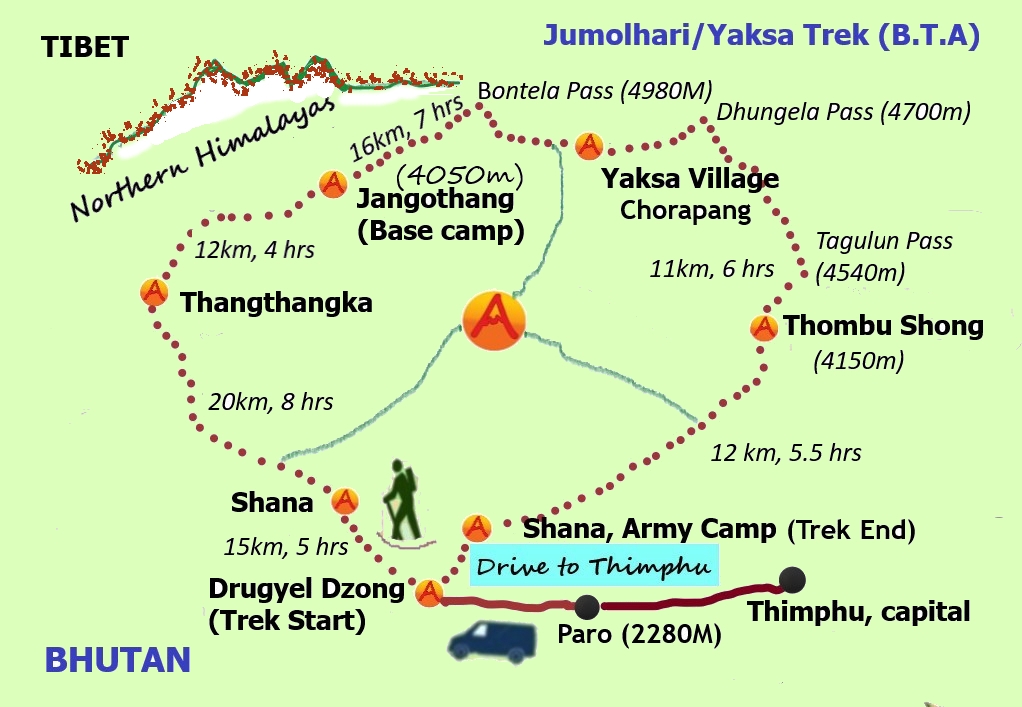
Day 01: Arrive Paro (By Druk Air)
The flight into Paro on our national carrier, Druk Air, is a befitting introduction to the spectacular beauty of our country. In clear weather, magnificent views of the world’s highest peaks, give way to the lush green Paro valley as you land. On arrival at Paro international airport, you will be received by our representative and will escort you to hotel. In the afternoon visit is Ta Dzong, an ancient watchtower, which now houses the National Museum. Below the museum is the Paro Rimpung Dzong, the centre of civil and religious authority in this valley. A short walk takes you to the base of the dzong and across a traditional cantilevered, covered bridge. A short distance further is one of the innumerable archery grounds. (Archery is the national sport of Bhutan). If we are lucky, we may catch a match in action.
Day 02: Paro hike to Taksang Monastery (Tiger Nest)
Right after the breakfast drive towards the road point to Taktshang. Taktshang Monastery, the most famous of Bhutan’s monasteries. Taktshang means “Tiger’s Nest,” so named because Guru Rimpoche reportedly flew to the site of the monastery on the back of a flying tiger in the late centuries of the first millennium. The monastery is perched on a cliff nearly 3,000 ft above the Paro valley floor. This day hike is not only historically and culturally interesting, but also incredibly scenic! It takes about two hours to reach the cafeteria, which gives a breathtaking view of the Tiger’s Nest. If you still feel like hiking then you can take another hour to reach the temple. Then return to hotel and free evening.
Day 03: Drukgyel Dzong (Paro) – Shana (trek)
Altitude: 2800m, Duration 5 hours, Distance 15 Km. Level of Difficulty: Easy
Starting from Drukgyel Dzong, the fortress that once guarded Paro Valley against Tibetan invaders, the first day is a pleasant walk following the left side of the Pachu River. The farm road serves as the trek route and passes through a number of very small villages with traditional houses, rice and vegetable fields to the left and right of the trail.
After about an hour’s walk, the farm road ends at Mitsizamp. Crossing a bridge to the right side of the river, the trail climbs very gradually for another hour through the trees to Zakhapang (2,600m), where nice lunch break-spot in an open and clean space is found. After lunch the trek continues through blue pine forests, following the river closely. Gunyitsawa army outpost appears not long before the end of the first day’s trek. The campsite at Shana, just beyond, is situated at an altitude of 2,820m in a beautiful open space surrounded by blue pine forest. Two traditional houses on the other side of the wide, fast-flowing river make up Shana village.
Day 04: Shana-Soi Thangthangka (trek)
Altitude: 3,750m, Duration 8 hours, Distance 20 Km. Level of Difficulty: Long but not difficult, Muddy and bumpy path sometimes
This is the longest trekking day, taking eight hours to reach the campsite. The trail continues to follow the river gradually ascending through a mixed forest of blue pine and oak and, later in the afternoon, tall rhododendron trees, birch, fir, and maple. Though the trail is a rocky and bumpy path, it is not strenuous but in rainy conditions, it can be quite muddy. There are several simple wooden bridges to cross and sometimes the river reaches right up to the trail. The lunch break comes after about 4 hours of walking through an ever-narrowing valley: Shing Karap or Thombuzam are popular stopping places at around 3,305m.
Several trails lead in other directions, such as the trail to Tremo la, which was the old salt-trading route to Tibet. Not long before reaching the campsite the trail leads you up a ridge with a chorten. Beyond, in the distance, at the end of the valley the Jumolhari Mountain comes into view. Finally, after an 8 hours walk, you reach the campsite. The camp site is located in spacious clearing and directly faces Mount Jumolhari. The view of early morning sun striking the tip of Jumolhari is breathtaking. Mount Jumolhari, at 7326, is among the world’s highest mountains.
Day 05: Soi-Thangthangka-Jangothang base camp (trek)
Altitude: 4050m, Duration 4 hours, Distance 12 Km. Level of Difficulty: Short and easy
The third day’s trek is a short one so it is possible to set off a little later and progress at a leisurely pace. When you reach the army outpost you are required to stop and register your entry permits issued by the army headquarters in Thimphu. This matter will be taken care of by your guide.
The Pachu River is again to the right and the trail passes through some very small villages. It will take less then four hours to reach Jangothang, Base Camp. The altitude at the base camp is 4,000m and is a beautiful place to spend the night. The imposing, rounded bulk of the Jumolhari Mountain fills the view to the Northeast and in the evening the profile of the ruined Jangothang Dzong, populated by huge ravens creates a mystical atmosphere. The area is rich in bird life. Birds sighted en route include the Fire-tailed Sunbird, Ibisbill, White throated Dipper, Yellow-billed Chough, Rosy Pipit, Snow Pigeon, Blue-fronted Redstart, Plumbeous Water Redstart, Blood Pheasant, Snow Partridge and many more.
Day 06: Jangothang Halt (trek)
Today is a day to rest and acclimatize to the altitude. The body also needs time to adjust to the falling temperatures, especially during the night. There is an opportunity to explore the valley and enjoy wonderful views of the mountains. A 2 hour’s leisurely hike will take you to the twin lakes of Tshophu. For those taking the Lingshi variation of the trek, this day trek hike is important. You can also enjoy the view of Cone-shape Jichu Drakey cannot fail to remind the clear blue sky. Jichu Drakey cannot fail to remind you of the Matterhorn from this perspective. It is a sight to hold! Many rank this as the most beautiful mountain in Bhutan.
Day 07: Jangothang- Dhumzo Chhu or Chorapang (trek)
Altitude: 3800m, Duration 7 ½ hours, Distance 16 Km. Level of Difficulty: Strenuous
On the way, you will see the view of Jhomolhari, Jitchu Drake, and the valley to the Jomolhari campsite. You will also come across several yak harder’s tents, Tsho Phu lakes, and normally see a flock of Himalayan blue Sheep high up on the rocky slopes. If you are lucky enough you may see the footprint of Snow Leopard at the Bonte La pass. Then the trail winds up to Bonte La (16,040 ft/4890m) which is also the highest pass of this trek. Take time to enjoy the scenery, have a snack, or put up some prayer flags. From here you can see Basingthang Peaks(5500m), Chatarake(Djo Drake, Jo Darkey (5570m), and Kanchenjunga, the third highest mountain in the world. The trail drops through a steep, narrow gully with gravel and loose rocks till you reach Dhumzo. The Soi Yaksa Valley is a beautiful site with impressive rock cliffs, waterfalls, deep side valleys, and snow- covered peaks. Overnight at the camp.
Day 08: Dhumzo Chhu – Thombu Shong (trek)
Altitude: 4150m, Duration 5 ½ hours, Distance 11 Km. Level of Difficulty: Moderate
You will have to climb from the camp through a rhododendron, birch, and oak forest draped in moss brings you to a meadow with a huge Juniper tree and then leads to Dhunge La (15,410ft/4700m) then to Tagulun La (14,880ft/4540m. You can also get a better view of Jhomolhari, Jitchu Drake, and Teri Kang, and in the distance, Kanchenjunga (28160ft/85840m) and even Makalu (27,760ft/8463m)blocking the view to Mount Everest. You can also see your tonight Thungbue camp. The Thangbue valley which has several stone huts-is busy in spring and autumn with several families and hundreds of yaks, horses, dogs, and goats. Thongbue camp is the second-highest camp for the trek.
Day 09: Thombu Shong – Shana (trek) – Drive to Paro
Altitude: 2800m, Duration 5 ½ hours, Distance 12 Km. Level of Difficulty: Moderate
Today you will cross the valley through a swampy area to a clear trail through rhododendron bushes climbing steeply to Thombu La (14,005ft/4270m). your can also see the several mountain peaks view from the pass. The ridge walk from the pass is one of the best parts of the trek: very high above the valleys on a good trail with a beautiful view. The trail descends steeply for 2 to 3 hours till you reach to the Shana where you will meet your car and driver. And drive for 45 minutes through the lovely valley, finishing your trek at Drugyel Dzong and then to your hotel in Paro for about another 30 minutes.
Day 10: Paro – Thimphu (Sightseeing)
Thimphu at an altitude of 3280 meters is the modern day capital of Bhutan. Sightseeing, visit the Memorial Chorten commissioned and built by the Queen Grand mother in memory of the late King. Visit the National Library, a treasure trove of priceless Buddhist manuscripts, visit the Traditional medicine centre where old healing arts such as acupuncture and herbal remedies are still practiced, the painting school, After 5 PM, visit Tashichho Dzong, “fortress of the glorious dharma” it is the center of government, religion, seat of the Kings Throne room and of the Je Khenpo or Chief abbot. It was rebuilt in the early 1960s after a fire destroyed most of the building. Overnight in Thimphu.
Day 11: Thimphu – Punakha (74 Km, 2 ½ hrs)
After breakfast, Drive to Punakha for 2 ½ hours with short stop at Dochula pass. If the weather is clear, you could have a superb view of the Bhutan’s Himalayas. Have lunch in Punakha town and visit beautiful Punakha Dzong built in 1637 by Shabdrung Ngawang Namgyal. Based on the prophecy of Guru Padmasambava the dzong is situated between two famous rivers, Pho Chu (Male River) and Mo Chu (Female River). Punakha was also the capital of Bhutan until 1955. Night halt in Punakha.
Day 12: Punakha – Paro sightseeing (115 Km, 3 ½ hrs)
Drive to Paro and check in at the hotel. Your lunch will be in Paro town. After lunch visit the Drugyel Dzong, or the fort of Drukpa victory which is almost 10 miles north from the town. From this fortress Bhutanese repelled several invasions by Tibetans throughout the course of history. Looming above the smoldered ruins if the whether is clear you can see the snowcapped peak of Mount. Jumolhari.
On the way back from Drugyel Dzong visit Kyichu temple, one of the last three surviving temples among 108 temples. In the 7th century a Tibetan King built 108 such temples. Till date only three had survived, two in Bhutan and one Tibet known as the Jokhang in Lhasa. In the evening you can stroll around the town and overnight stay at the hotel in Paro.
Day 13: Paro – Flight Depart
Our guide and driver will drop you to the airport and big you goodbye for your flight departure.
The minimum daily package covers the following services:
- Peak Season Cost: March, April, May, September, October & November
Staring Cost: USD 2,760 per person. - Regular Season Cost: June, July, August, December, January & February
Staring Cost: USD 2,430 per person
Note: Single Room Supplement Cost is, USD 30 per night for 3 Star hotels, USD 65 per night for 4 Star Hotels and around USD 300 for 5 Star Hotels.
The Flight cost for Singapore – Paro – Singapore is, USD 960 per person.
These rates are applicable per tourist per night halt in Bhutan.
1. What sort of past acclimatization/elevation and exercises do you need for this trek?
Ans – One must have done minimum 5-Day trek with at least 3300 meters and above quite recently and must be healthy and fit.
2. What is the minimum number of people required for the trek, and when is the best time or season?
Ans – We normally require minimum 2 people for the trek. yet, we can also conduct the trek for one person also. However, you will have to bear little additional cost. The best time for the trek is in the late spring or end of May, and then in the fall toward the end September.
3. What is the procedure for this trek booking?
Ans – You will have book this trek at least two months ahead with your confirmed flight booking. And then must deposit US $850 each/30% as an Advance Payment with full airfare only for your flight to/from Paro, Bhutan.
4. Why shall we book this adventure trek with your company?
Ans – We are one of the most local adventures travel company who can render personalized services, with value for money. We make sure to provide very good weather proof trekking equipment, skilled guide/tour leader, good cook and helpers, transports, etc, etc. And we arrange the trek on right time/season, so that it’s mostly a successful trek.
5. Do you apply our Bhutan Visa and what are the documents required for the Visa?
Ans – Yes, we will issue your Bhutan Visa upon receiving the full payment from you. And we only need your clear passport copy for applying the Visa.
6. Do we need to bring our sleeping bag, if so what type or how warm it must be?
Ans – Yes, you will have to bring your own sleeping bag. And it must be minimum minus 20 Degree Celsius dawn feather sleeping bag.
7. What are available flights connecting Bhutan with other cities, and what is the most convenient flight to/from Bhutan. And do you book the flights too?
Ans – We have flights to and from Bangkok, Kathmandu, Delhi, Kolkata, Dhaka, Singapore, Bagdogra and Guwahati. Yet, the most convenient flights to/fro Paro, Bhutan is via Bangkok as we have several flights in a day. Yes, we will book your flight as well, unless you want to do it at your end.


